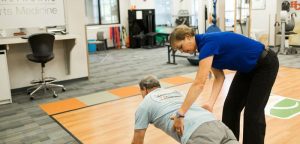Do you feel uncoordinated when you are carrying the laundry basket down stairs? Are you uneasy as you use the step stool to reach the top shelf? Or are you constantly avoiding any risk because you are afraid you may hurt yourself?
 Those are all normal as you age, but you can avoid those worries if you do one thing—strengthen your core.
Those are all normal as you age, but you can avoid those worries if you do one thing—strengthen your core.
In September, we recognize balance awareness week even though balance is something so many people take for granted. Kathy Boehmer, Specialty Program Coordinator for St. Elizabeth Healthcare, reminds us the key to balance and overall stability is core strength.
“Core strength is important for everything from balance to hip, knee, back and shoulder strength,” says Boehmer. “Your core supports every part of your body and even supports you in the simple daily tasks.”
The core is referring to the muscle groups in your abdomen, back and hips. It is the foundation the rest of your body needs for strength and stability. It links the upper and lower body, and the stronger that section is, the better you can move without losing your balance.
Core Strength Prevents Injury
Core strength isn’t about having a flat stomach—it can prevent injury. Kathy explains, “Core strength and balance support all of your movements. If your core can’t support the activities you are trying to do, it will put stress on the rest of your body and could result in injury.”
Even if you exercise regularly, if you don’t focus on your core, you are open to injury. Kathy explains how runners often have overuse injuries in the knee, hip and ankle that could be avoided.
She says, “Some runners will focus on the act of running and not build core muscles. They constantly work one group of muscles, the group that helps them run forward, which causes muscle imbalances and puts stress on the joints. Exercises should also include those that challenge the muscles on the sides and back of your body as well.”
Your joints are often the victim of poor core stability.
 Challenging Your Balance and Your Core
Challenging Your Balance and Your Core
Improving your balance isn’t difficult if you set aside time each day to do a few simple exercises. Kathy recommends focusing on four key exercises to keep you in balance:
- Standing Hip Flexion— Stand tall. Tighten your abdomen to stabilize your spine. Slowly lift one leg as if you are marching controlling your core muscles. Repeat 10-15 times alternating legs.
- Bridge—Lie on your back. Bend your knees with the bottom of your feet on the floor. Keep your feet hip distance apart. Tighten your abdomen to stabilize your spine. Lift your hips toward the ceiling, squeeze your buttocks and hold. Hold for as long as you can. Aim for a 10-second hold. Gently lower yourself. Rest and repeat 10 times.
- Full plank—Lie on your stomach with your legs straight. Tighten your abdomen to stabilize your spine. Push yourself up (lift your hips off the ground) into a push-up position so your back forms a straight line and balancing on your toes. Your hands should be under your shoulders and in a 90-degree position with your palms on the ground. Hold for as long as you can. Aim for a 30-second hold. Gently lower yourself. Rest and repeat.
- Standing Hip abduction— Stand on one leg. Tighten your abdomen to stabilize your spine. Lift your opposite leg slowly out to the side controlling your core muscles. Toes should be facing forward. Repeat 10-15 times. Switch legs and repeat.
Strengthening your core can prevent injury and balance problems. Don’t wait until you get injured to start strengthening your core. If you haven’t exercised in a few years or you have health issues, work with your doctor, a physical therapist or personal trainer who can make sure you are ready to start and modify the exercises if needed. To learn more about core strength, click here or call for an appointment at (859) 301-5600.
St. Elizabeth Healthcare
















